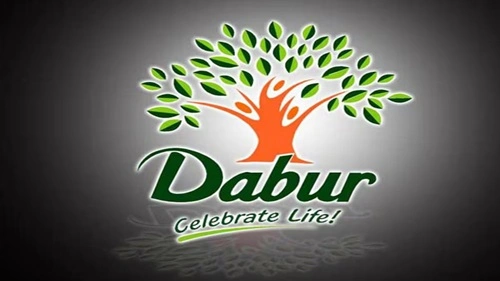Dabur, one of India’s leading Ayurvedic and wellness-focused FMCG companies, delivered ₹2,830 crore in Q4 FY 2025 revenue and a consolidated net profit of ₹320 crore, marking a YoY decline of ~8% due to sustained urban demand weakness and inflationary headwinds. Full-year FY 2025 revenue rose modestly to ₹12,563 crore, up ~1.3% YoY, while net profit for the year reached ₹1,768 crore, up roughly 4%. Despite sluggish domestic conditions, Dabur’s international business delivered strong constant-currency growth—19% in Q4 and 17% for the full year—helping stabilize performance. Against this backdrop, Dabur continues to expand its market leadership through Ayurveda-based innovation and a deep rural footprint.

Strengths
1. Deep Brand Heritage & Trust: Founded in 1884, Dabur’s Ayurvedic legacy positions it as one of India’s most trusted wellness brands, with strong equity across healthcare, hair care, oral care, and juice categories.
2. Extensive Product Portfolio & Distribution: Offering over 250+ products across personal care, healthcare, beverages, and more, Dabur reaches over 6 million retail outlets in India and operates in 100+ international markets.
3. Market Share Gains in Key Categories: In Q4 FY25, Dabur gained share across 90% of its portfolio: hair oils reached a record 19.1% share, juices jumped to 60.6%, and air-fresheners and toothpaste also widened shares.
4. Strong International Business: International operations grew at 19% CC in Q4 and 17% over the year, helping offset domestic softness.
5. Consistent R&D & Product Innovation: Dabur invests in Ayurvedic innovation—from immunity boosters to natural skincare—targeting health-conscious consumers and urban millennials.
Weaknesses
1. Dependence on Core Flagship Products: A significant share of revenue still comes from staples like Chyawanprash, Dabur Amla, and Real Juice, making growth vulnerable to category-specific demand swings.
2. Slow Growth Amid Urban Strain: Domestic demand remained muted for much of FY25. Food & beverages saw decline in Q4, and operating margins contracted in several categories.
3. Limited Premium Positioning: Dabur lags behind in premium personal care, organic wellness, and millennial-focused segments compared to global or D2C brands.
4. Regulatory & Quality Perception Risks: Issues like misleading “100% fruit juice” claims have attracted regulator scrutiny, potentially affecting brand trust in sensitive juice categories.
Opportunities
1. Premiumization & Wellness Expansion: Rising demand for Ayurveda-driven immunity, probiotic, and plant-based offerings provides scope for expanding price-realization through premium variants.
2. E-commerce & Digital Growth: Strengthening online reach—especially targeting urban millennials—can accelerate growth in high-engagement and direct-to-consumer channels.
3. Global Market Expansion: Untapped opportunity remains in Africa, MEA, and SAARC via exports, acquisitions, and local partnerships to enhance overseas revenue.
4. Diversification into Adjacent Categories: Building on acquisitions like Badshah Masala and Sesa Care, Dabur can drive growth in food tech, personal wellness, and skincare niches.
5. Sustainability & ESG Alignment: With goals like net-zero carbon by 2045 and greater renewable energy adoption, Dabur can attract ESG-sensitive consumers and institutional capital.
Threats
1. Intense FMCG Competition: Dabur faces competition from global giants like HUL, ITC, and local players including Patanjali—especially in urban and premium segments.
2. Economic & Rural Volatility: A downturn in rural income or high food inflation could sharply impact sales in one of its key distribution levers.
3. Raw Material Inflation: Price volatility in herbal extracts, packaging and supply-chain costs poses margin risk if not offset timely.
4. Regulation & Quality Challenges: Any adverse regulatory rulings on product claims or quality issues in foreign markets could impair brand reputation, especially in juices and healthcare segments.
5. Threat of Brand Dilution: Expanding across too many segments without clear brand segmentation could dilute Dabur’s Ayurvedic positioning among core consumers.
Future Outlook
Urban & Rural Demand Recovery: If urban spending recovers in the next two fiscal quarters and economic conditions stabilize, Dabur could regain topline momentum—especially through premium and rural channels.
Margin Improvement via Mix & Productivity: Continued market share gains, better cost management, and efficiency in advertising spend (down ~4% Q4) may support margin recovery going into FY26.
Health & F&B Growth Engine: Foods business grew ~14% in Q4, and further supplements and wellness offerings may deliver higher-margin revenue streams.
International Growth Contribution: Strong 17–19% growth in overseas operations offers a more stable base, especially as India demand fluctuates.
Digital-First Innovation & Brand Refresh: Greater investment in D2C, millennial Ayurvedic IPL-style branding, and clean-label launches can help tap new segments and rejuvenate youth relevance.
Strategic Acquisitions & Category Expansion: Consolidation in wellness, F&B, and skin care categories—like the recent Badshah and Sesa Care deals—could broaden the revenue base and reduce reliance on legacy products.
Dabur India remains a trusted FMCG stalwart, fortified by centuries of Ayurvedic brand equity and scale. Yet challenges in urban demand, category headwinds, and rising competition demand strategic reorientation. Strong execution in premium offerings, digital innovation, and global growth—combined with operational discipline—will determine whether Dabur sustains leadership or drifts toward stagnation in India’s fast-evolving FMCG landscape.